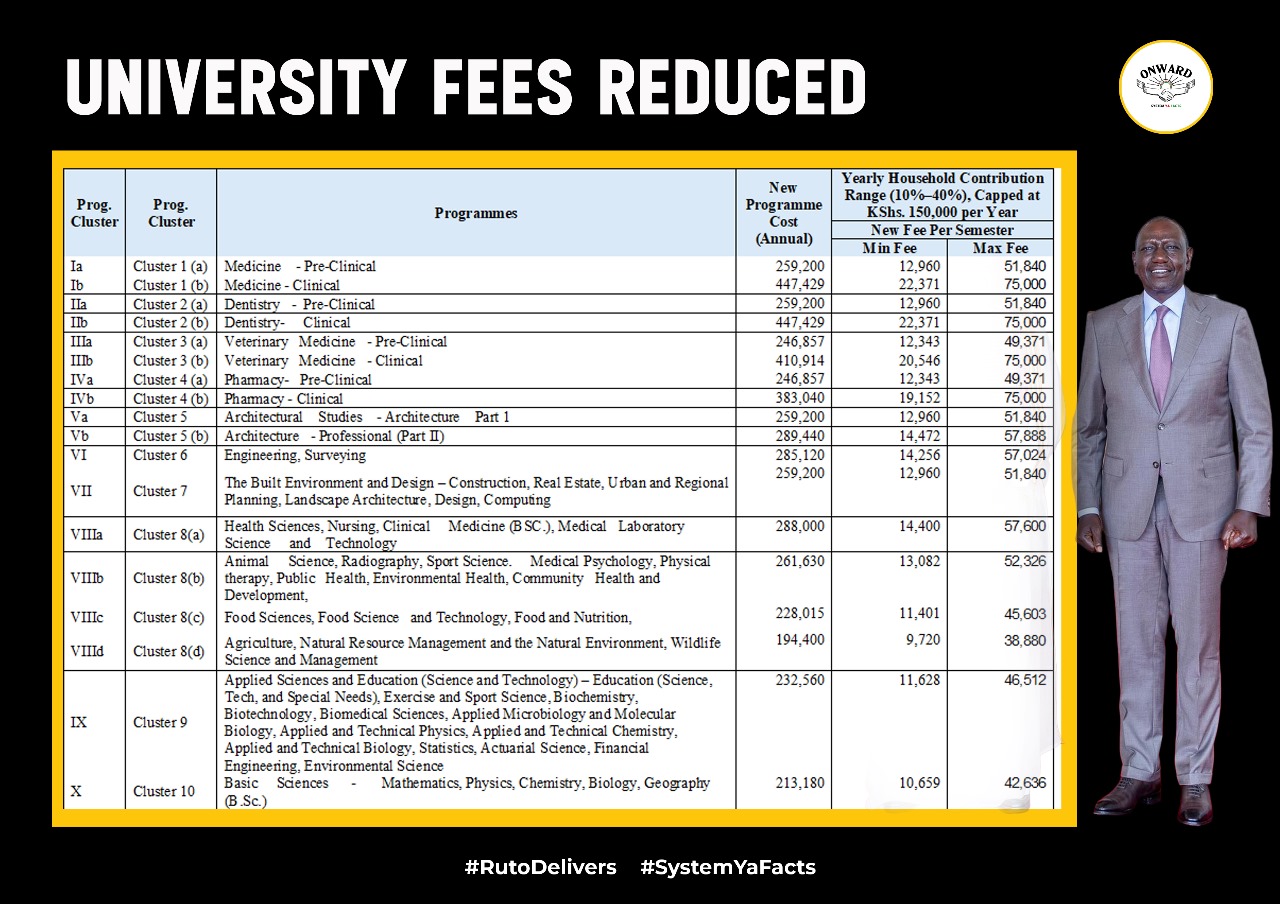Government Slashes University Fees Ahead of September 2025 Intake
Students to enjoy lower tuition across all public universities under new MoE directive. In a landmark move to boost access to higher education, the Ministry of Education has officially reduced fees payable by students in public universities, effective September 1, 2025. The sweeping directive — issued on July 30 and communicated to all vice chancellors and councils — standardizes tuition costs across various programme clusters and aims to ease the financial burden on Kenyan families.

The directive mandates the adoption of a new, harmonized fee structure across all academic programmes and clusters. This reform is a response to years of complaints from student organizations, education watchdogs, and parents, who have decried high tuition rates as a barrier to education for children from low-income families.
Why the Fee Cut Matters
Speaking during a press briefing at Jogoo House, Education Cabinet Secretary Ezekiel Machogu emphasized that the new policy aligns with the government's broader commitment to equity and inclusion in education.
"No Kenyan should miss out on university education due to financial constraints. This is a right, not a privilege," said CS Machogu.
He noted that the new fee schedule will not only enhance access but also reduce the dropout rate among continuing students who struggle to keep up with tuition fees. The CS called upon universities to begin immediate compliance, including reissuing admission letters with updated tuition rates and adjusting their student portals accordingly.
The directive comes on the back of mounting pressure from various stakeholders. In April 2025, students from the University of Nairobi, Kenyatta University, and Maseno University staged coordinated peaceful demonstrations demanding government intervention. They cited excessive tuition charges, especially in medical, engineering, and science programmes, as a primary cause of stress and discontinuation.
Data-Driven Reform
According to a 2024 report by the Kenya Institute for Public Policy Research and Analysis (KIPPRA):
-
61% of university students relied heavily on HELB loans and bursaries to fund their education.
-
42% of households earning below Ksh 30,000 per month reported difficulty in paying university fees.
-
27% of qualified KCSE candidates opted out of public universities citing unaffordable costs.
The report concluded that reducing tuition fees in public institutions was not only necessary but urgent, to preserve the country’s human capital pipeline and reduce long-term inequality.
What Students Should Expect
Effective September 2025:
-
First-year students will pay reduced rates as outlined in the new schedule.
-
Continuing students will transition to the new structure.
-
Private universities are not affected by this directive.
-
HELB loan limits remain unchanged (Ksh 70,000 per year), though a review is anticipated by early 2026.
Key Instructions to Universities
The MoE outlined the following urgent requirements:
-
Reissue updated admission letters to all affected students by August 15, 2025.
-
Update all online student portals to reflect the new fees.
-
Coordinate with HELB to ensure alignment between tuition and funding.
Vice chancellors have been warned that non-compliance could lead to funding cuts in the 2026/2027 financial year.
Voices From the Ground
“We’ve waited for this decision for years. My daughter is studying engineering and our annual cost has been over Ksh 200,000. This is the relief we needed,” said Millicent Otieno, a parent in Kisumu.
“We welcome the move but urge the government to ensure that university quality doesn’t suffer in the process. Labs, libraries, and infrastructure need consistent funding,” added John Maina, a student leader at Kenyatta University.
Full Breakdown of Revised Fees per Semester (KSh)
Health & Medical Sciences
| Cluster | Programme | Fee Range |
|---|---|---|
| 1a | Medicine (Pre-Clinical) | 12,960 - 51,840 |
| 1b | Medicine (Clinical) | 22,371 - 75,000 |
| 2a | Dentistry (Pre-Clinical) | 12,960 - 51,840 |
| 2b | Dentistry (Clinical) | 22,371 - 75,000 |
| 3a | Veterinary Medicine (Pre-Clinical) | 22,371 - 75,000 |
| 3b | Veterinary Medicine (Clinical) | 12,343 - 49,371 |
| 4a | Pharmacy (Pre-Clinical) | 20,546 - 75,000 |
| 4b | Pharmacy (Clinical) | 19,152 - 49,371 |
Architecture & Engineering
| Cluster | Programme | Fee Range |
|---|---|---|
| 5a | Architecture (Part I) | 12,960 - 75,000 |
| 5b | Architecture (Part II - Prof.) | 14,472 - 57,888 |
| 6 | Engineering, Surveying | 14,256 - 57,024 |
| 7 | Built Env. & Design, Real Estate | 14,400 - 51,840 |
Agriculture, Food & Environment
| Cluster | Programme | Fee Range |
|---|---|---|
| 8a | Animal Science, Public Health | 13,082 - 57,600 |
| 8b | Food Sciences & Nutrition | 11,401 - 52,326 |
| 8c | Agriculture & Wildlife Mgmt | 9,720 - 45,603 |
Education & Applied Sciences
| Cluster | Programme | Fee Range |
|---|---|---|
| 9 | Education (Science), Stats, Biotech, Actuarial Science | 11,628 - 46,512 |

Bottom Line
The Ministry's bold step is expected to restore hope to many families and stabilize enrollment across Kenya's 38 public universities and their constituent colleges. While the reduced fees are a major win for accessibility, experts warn that maintaining educational quality will depend on how the Treasury and university administrations adjust their operational budgets.
What's Your Reaction?





















